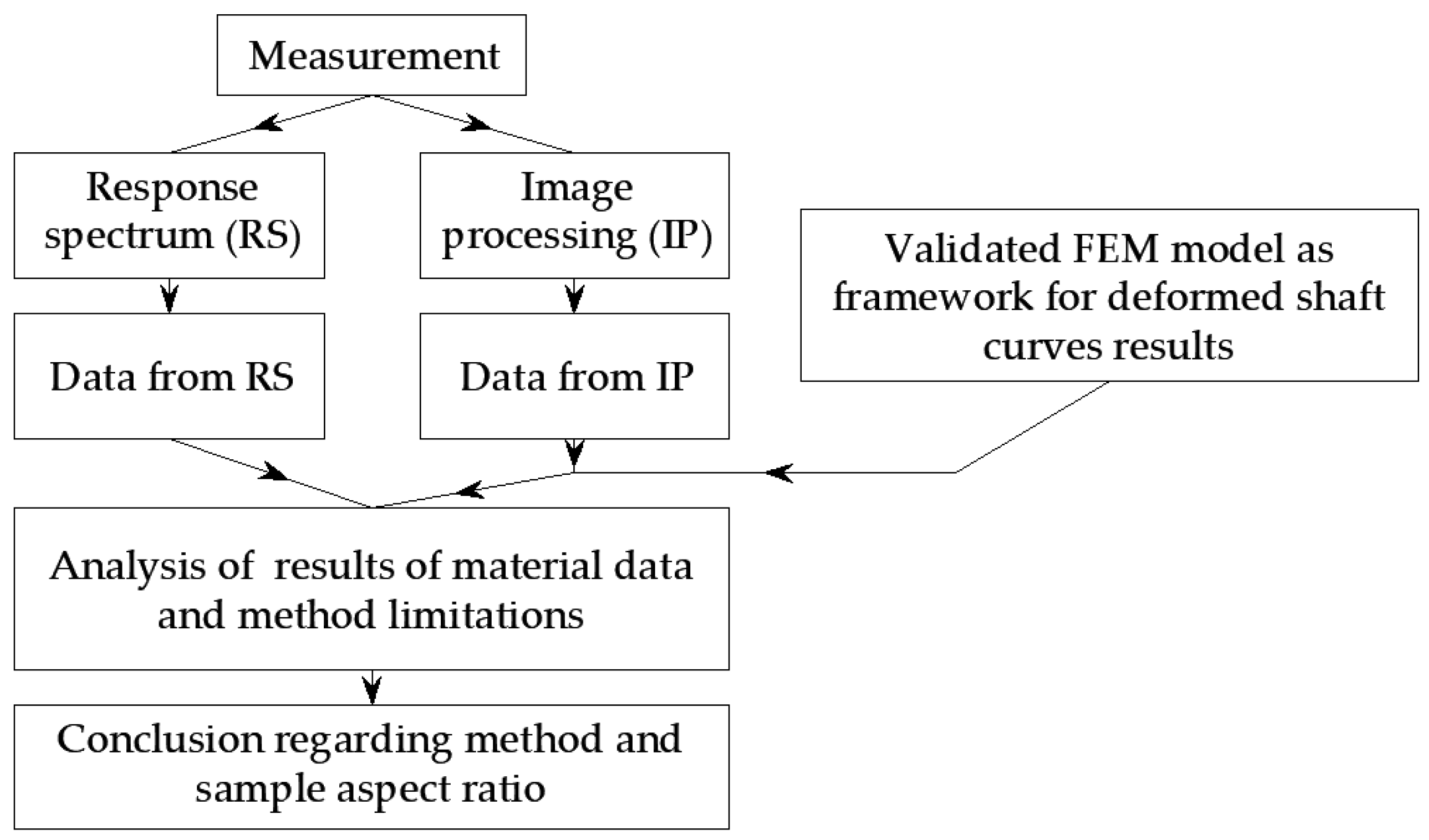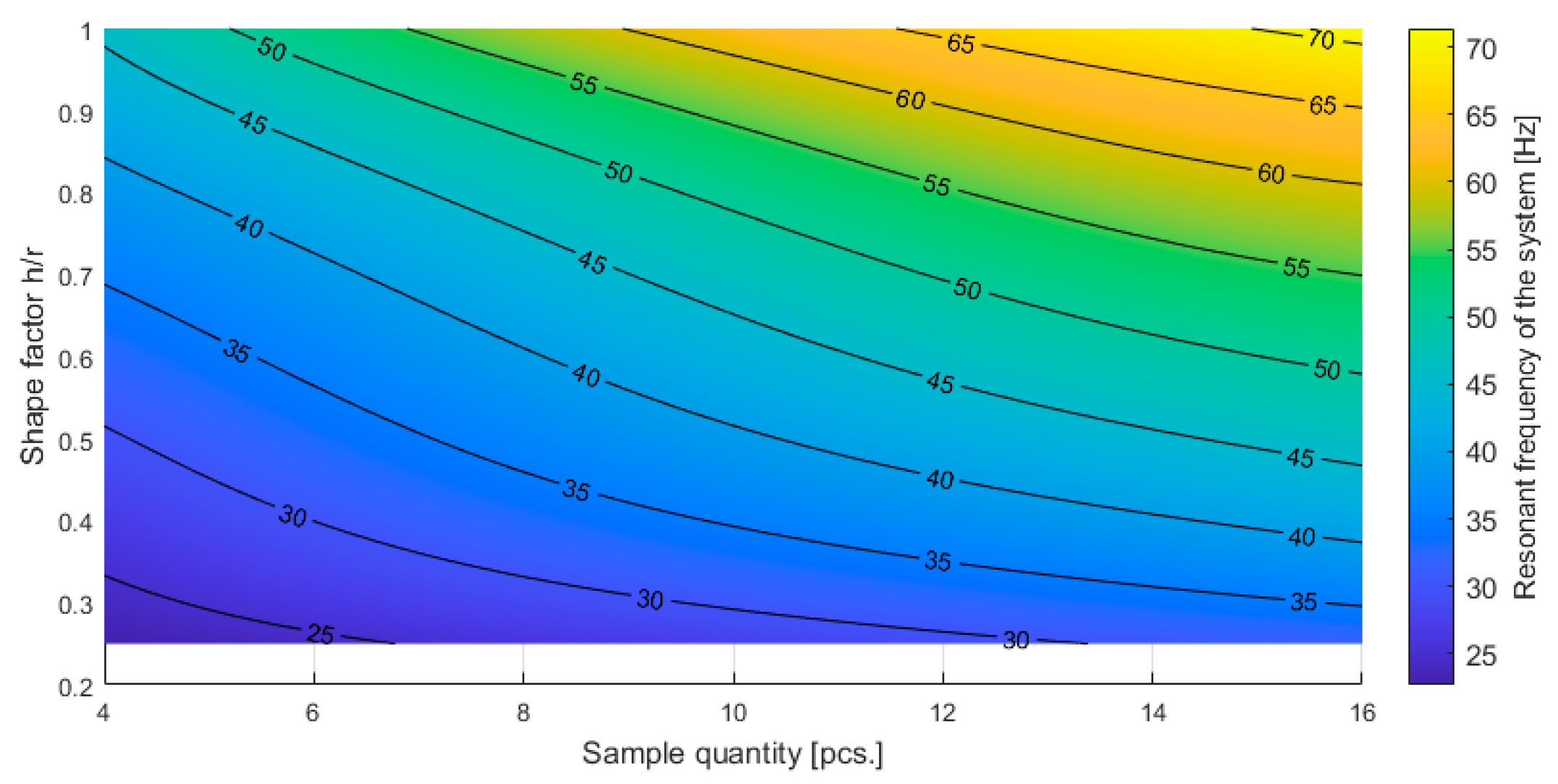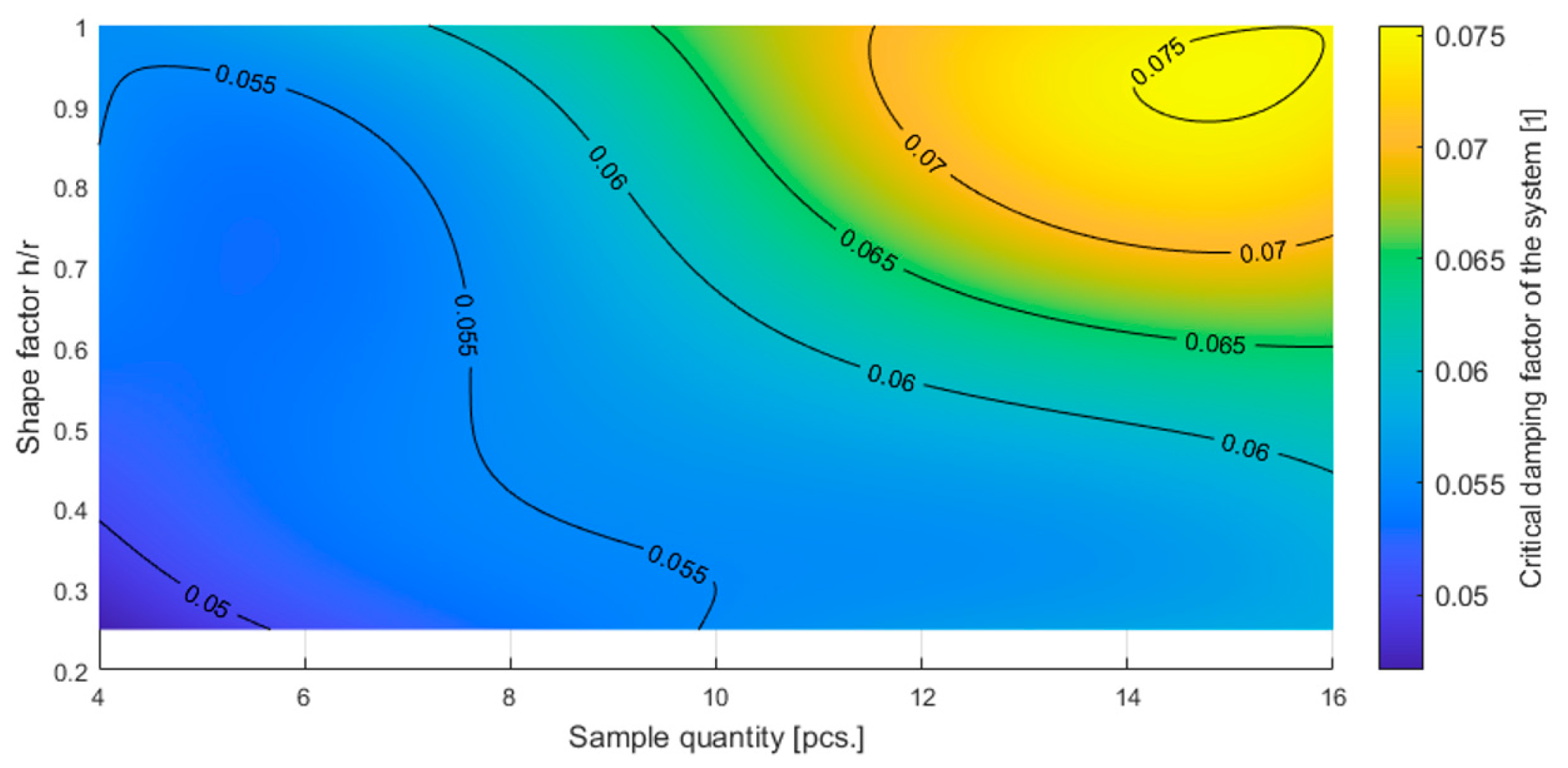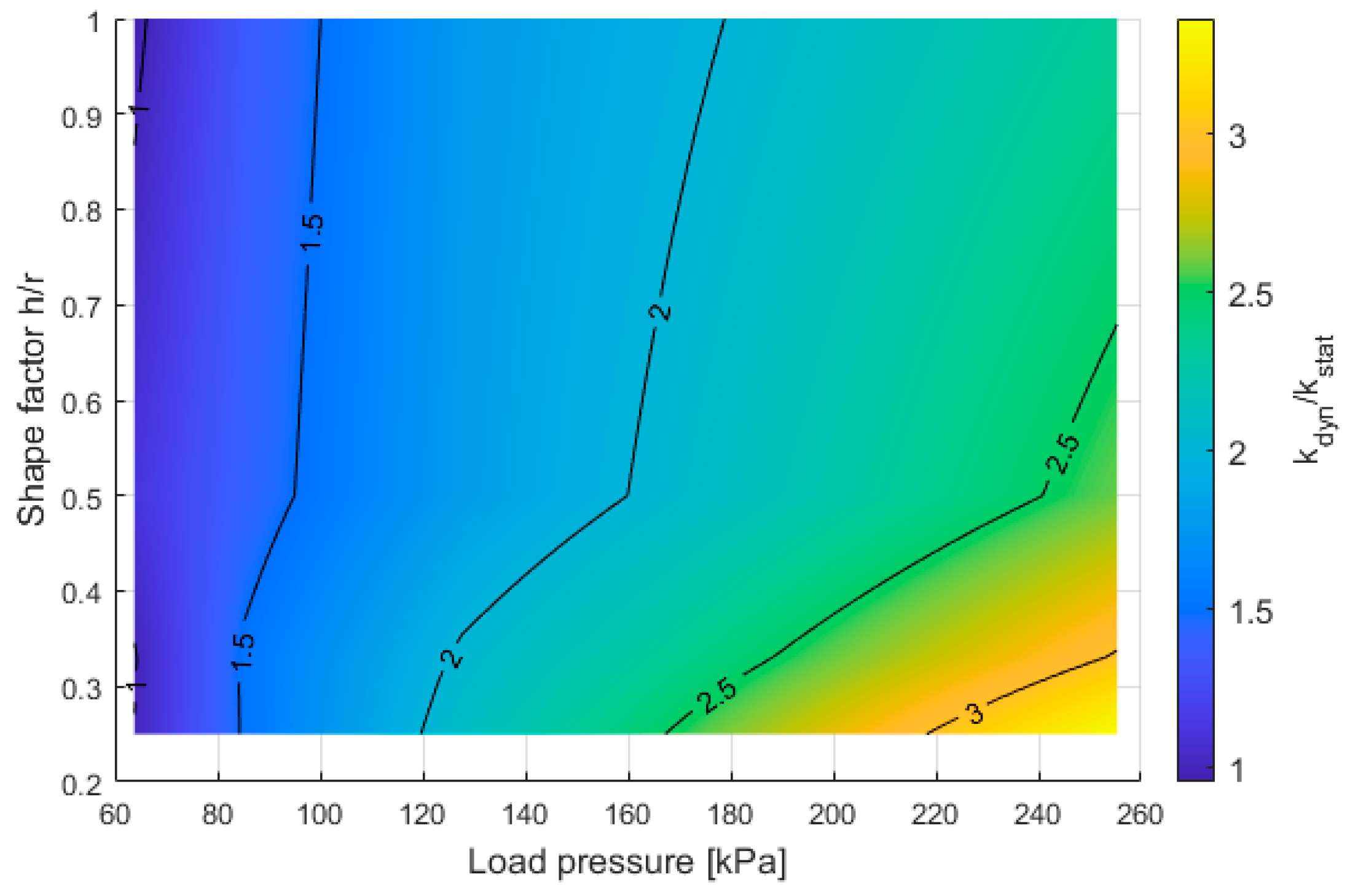A Low-Stress Method for Determining Static and Dynamic Material Parameters for Vibration Isolation with the Use of VMQ Silicone
Abstract
:1. Introduction
2. Measurement Procedure
2.1. Response Spectrum
2.2. Image Processing
2.3. FEM Model
2.4. Bulge Shape Fitting–Lowest RMSE Fit
3. Results
3.1. Response Spectrum
3.2. Image Analysis
4. Discussion
4.1. Derived Quantities
4.1.1. Rayleigh Damping
4.1.2. Spring Stiffness, Static and Dynamic—kstat and kdyn
4.1.3. Damping Coefficient
4.1.4. Loss Factor
4.2. Poisson Ratio
4.3. Poisson Ratio Using Apparent Young’s Modulus
4.4. Young’s Modulus
5. Conclusions
Author Contributions
Funding
Institutional Review Board Statement
Informed Consent Statement
Data Availability Statement
Acknowledgments
Conflicts of Interest
References
- Kanka, S.; Fredianelli, L.; Artuso, F.; Fidecaro, F.; Licitra, G. Evaluation of Acoustic Comfort and Sound Energy Transmission in a Yacht. Energies 2023, 16, 808. [Google Scholar] [CrossRef]
- Kang, C.-W.; Jang, S.-S.; Hashitsume, K.; Kolya, H. Estimation of impact sound reduction by wood flooring installation in a wooden building in Korea. J. Build. Eng. 2023, 64, 105708. [Google Scholar] [CrossRef]
- Di, H.; Su, G.; Yu, J.; Xu, Y.; Xu, P.; Zhou, S. Field measurement and evaluation of vibrations inside buildings above metro tunnels. Soil Dyn. Earthq. Eng. 2023, 166, 107767. [Google Scholar] [CrossRef]
- Tao, Z.; Moore, J.A.; Sanayei, M.; Wang, Y.; Zou, C. Train-induced floor vibration and structure-borne noise predictions in a low-rise over-track building. Eng. Struct. 2022, 255, 113914. [Google Scholar] [CrossRef]
- Rocca, M.; Di Puccio, F.; Forte, P.; Leccese, F. Acoustic comfort requirements and classifications: Buildings vs. yachts. Ocean Eng. 2022, 255, 111374. [Google Scholar] [CrossRef]
- Liu, H.; Lin, X.; Gong, Z.; Shi, J. Combined Annoyance Assessment of Ship Structural Vibration and Ambient Noise. Buildings 2023, 13, 363. [Google Scholar] [CrossRef]
- Croy, I.; Smith, M.G.; Waye, K.P. Effects of train noise and vibration on human heart rate during sleep: An experimental study. BMJ Open 2013, 3, e002655. [Google Scholar] [CrossRef] [Green Version]
- Licitra, G.; Fredianelli, L.; Petri, D.; Vigotti, M.A. Annoyance evaluation due to overall railway noise and vibration in Pisa urban areas. Sci. Total Environ. 2016, 568, 1315–1325. [Google Scholar] [CrossRef]
- Nering, K.; Kowalska-Koczwara, A.; Stypuła, K. Annoyance Based Vibro-Acoustic Comfort Evaluation of as Summation of Stimuli Annoyance in the Context of Human Exposure to Noise and Vibration in Buildings. Sustainability 2020, 12, 9876. [Google Scholar] [CrossRef]
- Gidlöf-Gunnarsson, A.; Jerson, T.; Ögren, M.; Öhrström, E. Railway noise annoyance and the importance of number of trains, ground vibration, and building situational factors. Noise Health 2012, 14, 190–201. [Google Scholar] [CrossRef]
- Michaud, D.S.; Feder, K.; Keith, S.E.; Voicescu, S.A.; Marro, L.; Than, J.; Guay, M.; Denning, A.; Murray, B.J.; Weiss, S.K.; et al. Corrigendum: Effects of Wind Turbine Noise on Self-Reported and Objective Measures of Sleep. Sleep 2018, 41, 97–109. [Google Scholar] [CrossRef] [Green Version]
- Mucci, N.; Traversini, V.; Lorini, C.; De Sio, S.; Galea, R.P.; Bonaccorsi, G.; Arcangeli, G. Urban Noise and Psychological Distress: A Systematic Review. Int. J. Environ. Res. Public Health 2020, 17, 6621. [Google Scholar] [CrossRef] [PubMed]
- Zaharna, M.; Guilleminault, C. Sleep, noise and health: Review. Noise Health 2010, 12, 64–69. [Google Scholar] [CrossRef]
- Chao, P.; Juang, Y.; Chen, C.; Dai, Y.; Yeh, C.; Hu, C. Combined effects of noise, vibration, and low temperature on the physiological parameters of labor employees. Kaohsiung J. Med. Sci. 2013, 29, 560–567. [Google Scholar] [CrossRef] [Green Version]
- Münzel, T.; Schmidt, F.P.; Steven, S.; Herzog, J.; Daiber, A.; Sørensen, M. Environmental Noise and the Cardiovascular System. J. Am. Coll. Cardiol. 2018, 71, 688–697. [Google Scholar] [CrossRef]
- Gupta, A.; Gupta, A.; Jain, K.; Gupta, S. Noise Pollution and Impact on Children Health. Indian J. Pediatr. 2018, 85, 300–306. [Google Scholar] [CrossRef] [PubMed]
- Mohammadi, G. An Investigation of Community Response to Urban Traffic Noise. In Global Perspective for Competitive Enterprise, Economy and Ecology: Proceedings of the 16th ISPE International Conference on Concurrent Engineering; Springer: London, UK, 2009; pp. 673–680. [Google Scholar] [CrossRef] [Green Version]
- Zannin, P.H.; Calixto, A.; Diniz, F.B.; Ferreira, J.A. A survey of urban noise annoyance in a large Brazilian city: The importance of a subjective analysis in conjunction with an objective analysis. Environ. Impact Assess. Rev. 2003, 23, 245–255. [Google Scholar] [CrossRef]
- Issever, H.; Aksoy, C.; Sabuncu, H.; Karan, A. Vibration and Its Effects on the Body. Med. Princ. Pract. 2003, 12, 34–38. [Google Scholar] [CrossRef]
- Jinfeng, R.; Lin, W.; Pei, L. Summary of Research on Supporting Facilities and Structure Vibration and Noise Reduction of High-Rise Buildings. IOP Conf. Ser. Earth Environ. Sci. 2021, 791, 012023. [Google Scholar] [CrossRef]
- Fiala, P.; Degrande, G.; Augusztinovicz, F. Numerical modelling of ground-borne noise and vibration in buildings due to surface rail traffic. J. Sound Vib. 2007, 301, 718–738. [Google Scholar] [CrossRef]
- Kim, T.M.; Kim, J.T.; Kim, J.S. Effect of structural vibration and room acoustic modes on low frequency impact noise in apartment house with floating floor. Appl. Acoust. 2018, 142, 59–69. [Google Scholar] [CrossRef]
- Schiavi, A. Improvement of impact sound insulation: A constitutive model for floating floors. Appl. Acoust. 2018, 129, 64–71. [Google Scholar] [CrossRef]
- Lasowicz, N.; Kwiecień, A.; Jankowski, R. Experimental Study on the Effectiveness of Polyurethane Flexible Adhesive in Reduction of Structural Vibrations. Polymers 2020, 12, 2364. [Google Scholar] [CrossRef] [PubMed]
- Ibrahim, R. Recent advances in nonlinear passive vibration isolators. J. Sound Vib. 2008, 314, 371–452. [Google Scholar] [CrossRef]
- Rousakis, T.; Papadouli, E.; Sapalidis, A.; Vanian, V.; Ilki, A.; Halici, O.; Kwiecień, A.; Zając, B.; Hojdys, Ł.; Krajewski, P.; et al. Flexible joints between RC frames and masonry infill for improved seismic performance—Shake table tests. In Brick and Block Masonry—From Historical to Sustainable Masonry; CRC Press: Boca Raton, FL, USA, 2020; pp. 499–507. [Google Scholar] [CrossRef]
- Kwiecień, A.; Kubon, P. Dynamic Analysis of Damaged Masonry Building Repaired with the Flexible Joint Method / Analiza Dynamiczna Uszkodzonego Murowanego Budynku Naprawionego Z Zastosowaniem Polimerowego Złacza Podatnego. Arch. Civ. Eng. 2012, 58, 39–55. [Google Scholar] [CrossRef] [Green Version]
- Akyildiz, A.T.; Kowalska-Koczwara, A.; Kwiecien, A. Influence of Joint Connection Modelling on Dynamic Characteristic of the Buildings. IOP Conf. Ser. Mater. Sci. Eng. 2019, 471, 052062. [Google Scholar] [CrossRef]
- Bluyssen, P.M. Towards new methods and ways to create healthy and comfortable buildings. Build. Environ. 2010, 45, 808–818. [Google Scholar] [CrossRef]
- Kowalska-Koczwara, A.; Pachla, F.; Nering, K. Environmental Protection Against Noise and Vibration. IOP Conf. Ser. Mater. Sci. Eng. 2021, 1203, 032026. [Google Scholar] [CrossRef]
- Nering, K. Perception of Structure-Borne Sound in Buildings in Context of Vibration Comfort of Human in the Buildings. IOP Conf. Ser. Mater. Sci. Eng. 2020, 960, 022033. [Google Scholar] [CrossRef]
- Fu, H.; Kaewunruen, S. State-of-the-Art Review on Additive Manufacturing Technology in Railway Infrastructure Systems. J. Compos. Sci. 2021, 6, 7. [Google Scholar] [CrossRef]
- Zuo, Z.; Liu, L.; Zhou, Y.; Qin, J.; Cui, W. Acoustic Radiation Study of a Box Girder Viaduct Considering the Frequency-Dependent Viscoelasticity of the Rail Pad. Buildings 2022, 12, 1226. [Google Scholar] [CrossRef]
- Zou, C.; Wang, Y.; Tao, Z. Train-Induced Building Vibration and Radiated Noise by Considering Soil Properties. Sustainability 2020, 12, 937. [Google Scholar] [CrossRef] [Green Version]
- Hao, Y.; Qi, H.; Liu, S.; Nian, V.; Zhang, Z. Study of Noise and Vibration Impacts to Buildings Due to Urban Rail Transit and Mitigation Measures. Sustainability 2022, 14, 3119. [Google Scholar] [CrossRef]
- Wrótny, M.; Bohatkiewicz, J. Impact of Railway Noise on People Based on Strategic Acoustic Maps. Sustainability 2020, 12, 5637. [Google Scholar] [CrossRef]
- Connolly, D.P.; Marecki, G.P.; Kouroussis, G.; Thalassinakis, I.; Woodward, P.K. The growth of railway ground vibration problems—A review. Sci. Total Environ. 2016, 568, 1276–1282. [Google Scholar] [CrossRef]
- ISO 12354-1:2017; Building acoustics—Estimation of acoustic performance of buildings from the performance of elements—Part 1: Airborne sound insulation between rooms. International Organization for Standardization: Geneva, Switzerland, 2017.
- ISO 12354-2:2017; Building acoustics—Estimation of acoustic performance of buildings from the performance of elements—Part 2: Impact sound insulation between rooms. International Organization for Standardization: Geneva, Switzerland, 2017.
- Galbrun, L. The prediction of airborne sound transmission between two rooms using first-order flanking paths. Appl. Acoust. 2008, 69, 1332–1342. [Google Scholar] [CrossRef]
- Eddin, M.B.; Ménard, S.; Hagberg, D.B.; Kouyoumji, J.-L.; Vardaxis, N.-G. Prediction of Sound Insulation Using Artificial Neural Networks—Part I: Lightweight Wooden Floor Structures. Acoustics 2022, 4, 203–226. [Google Scholar] [CrossRef]
- Eddin, M.B.; Vardaxis, N.-G.; Ménard, S.; Hagberg, D.B.; Kouyoumji, J.-L. Prediction of Sound Insulation Using Artificial Neural Networks—Part II: Lightweight Wooden Façade Structures. Appl. Sci. 2022, 12, 6983. [Google Scholar] [CrossRef]
- Saaed, T.E.; Nikolakopoulos, G.; Jonasson, J.-E.; Hedlund, H. A state-of-the-art review of structural control systems. J. Vib. Control 2013, 21, 919–937. [Google Scholar] [CrossRef]
- Vogiatzis, K.; Mouzakis, H. Ground_borne noise and vibration transmitted from subway networks to multi_storey reinforced concrete buildings. Transport 2017, 33, 446–453. [Google Scholar] [CrossRef] [Green Version]
- Luo, Y.; Liu, Y.; Yin, H. Numerical investigation of nonlinear properties of a rubber absorber in rail fastening systems. Int. J. Mech. Sci. 2013, 69, 107–113. [Google Scholar] [CrossRef] [Green Version]
- Kun, L.; Lei, X.; Zeng, S. Influence analysis on the effect of rail fastening parameters on the vibration response of track–bridge system. Adv. Mech. Eng. 2017, 9, 168781401770283. [Google Scholar] [CrossRef] [Green Version]
- Zhang, P.; Li, S.; Núñez, A.; Li, Z. Vibration modes and wave propagation of the rail under fastening constraint. Mech. Syst. Signal Process. 2021, 160, 107933. [Google Scholar] [CrossRef]
- Lakušić, S.; Haladin, I.; Ahac, M. The Effect of Rail Fastening System Modifications on Tram Traffic Noise and Vibration. Shock. Vib. 2016, 2016, 4671302. [Google Scholar] [CrossRef]
- Nowotny, Ł.; Nurzyński, J. The Influence of Insulating Layers on the Acoustic Performance of Lightweight Frame Floors Intended for Use in Residential Buildings. Energies 2020, 13, 1217. [Google Scholar] [CrossRef] [Green Version]
- Vardaxis, N.-G.; Hagberg, D.B.; Dahlström, J. Evaluating Laboratory Measurements for Sound Insulation of Cross-Laminated Timber (CLT) Floors: Configurations in Lightweight Buildings. Appl. Sci. 2022, 12, 7642. [Google Scholar] [CrossRef]
- e Sousa, A.N.; Gibbs, B. Low frequency impact sound transmission in dwellings through homogeneous concrete floors and floating floors. Appl. Acoust. 2011, 72, 177–189. [Google Scholar] [CrossRef]
- Schiavi, A.; Belli, A.P.; Russo, F. Estimation of Acoustical Performance of Floating Floors from Dynamic Stiffness of Resilient Layers. Build. Acoust. 2005, 12, 99–113. [Google Scholar] [CrossRef]
- Kim, S.; Hwang, J.; Ryu, J.; Song, M. Prediction of Vibration-Mode-Induced Noise of Structure–Acoustic Coupled Systems. Appl. Sci. 2022, 12, 10496. [Google Scholar] [CrossRef]
- Qian, C.; Ménard, S.; Bard, D.; Negreira, J. Development of a Vibroacoustic Stochastic Finite Element Prediction Tool for a CLT Floor. Appl. Sci. 2019, 9, 1106. [Google Scholar] [CrossRef] [Green Version]
- Park, H.S.; Oh, B.K.; Kim, Y.; Cho, T. Low-frequency impact sound transmission of floating floor: Case study of mortar bed on concrete slab with continuous interlayer. Build. Environ. 2015, 94, 793–801. [Google Scholar] [CrossRef]
- Cho, T. Experimental and numerical analysis of floating floor resonance and its effect on impact sound transmission. J. Sound Vib. 2013, 332, 6552–6561. [Google Scholar] [CrossRef]
- Kim, Y.-C.; Shahriyer, H.; Hu, J.-W. Seismic Performance Evaluation According to HSS and CFST Columns of 3D Frame Buildings with Rubber Friction Bearing (RFB). Materials 2022, 15, 1281. [Google Scholar] [CrossRef]
- Çelebi, E.; Göktepe, F. Non-linear 2-D FE analysis for the assessment of isolation performance of wave impeding barrier in reduction of railway-induced surface waves. Constr. Build. Mater. 2012, 36, 1–13. [Google Scholar] [CrossRef]
- Mu, T.; Zhou, L.; Yang, J.N. Comparison of adaptive structural damage identification techniques in nonlinear hysteretic vibration isolation systems. Earthq. Eng. Eng. Vib. 2013, 12, 659–667. [Google Scholar] [CrossRef]
- Zhu, Y.-P.; Lang, Z.Q.; Fujita, K.; Takewaki, I. The design of nonlinear damped building isolation systems by using mobility analysis. Front. Built Environ. 2022, 8, 971260. [Google Scholar] [CrossRef]
- Guan, D.; Cong, X.; Li, J.; Shen, H.; Zhang, C.; Gong, J. Quantitative characterization of the energy harvesting performance of soft-contact sphere triboelectric nanogenerator. Nano Energy 2021, 87, 106186. [Google Scholar] [CrossRef]
- Gent, A.N. On the relation between indentation hardness and Young’s modulus. Rubber Chem. Technol. 1958, 31, 896–906. [Google Scholar] [CrossRef]
- Qi, H.J.; Joyce, K.; Boyce, M.C. Durometer Hardness and the Stress-Strain Behavior of Elastomeric Materials. Rubber Chem. Technol. 2003, 76, 419–435. [Google Scholar] [CrossRef]
- Pampush, J.D.; Daegling, D.J.; Vick, A.E.; McGraw, W.S.; Covey, R.M.; Rapoff, A.J. Technical note: Converting durometer data into elastic modulus in biological materials. Am. J. Phys. Anthr. 2011, 146, 650–653. [Google Scholar] [CrossRef]
- EN 29052-1:2011/ISO 9052-1; Acoustics—Determination of Dynamic Stiffness—Part 1: Materials Used under Floating Floors in Dwellings. International Organization for Standardization: Geneva, Switzerland, 1992. Available online: https://standards.iteh.ai/catalog/standards/cen/04a2dad0-ff01-4409-b2d4-6d6d62feb5c7/en-29052-1-1992 (accessed on 1 December 2022).
- Nering, K.; Kowalska-Koczwara, A. Determination of Vibroacoustic Parameters of Polyurethane Mats for Residential Building Purposes. Polymers 2022, 14, 314. [Google Scholar] [CrossRef] [PubMed]
- Chmielewski, T.; Zembaty, Z. Basics of Structural Mechanics; Arkady: Warsaw, Poland, 1998. (In Polish) [Google Scholar]
- Papagiannopoulos, G.A.; Hatzigeorgiou, G. On the use of the half-power bandwidth method to estimate damping in building structures. Soil Dyn. Earthq. Eng. 2011, 31, 1075–1079. [Google Scholar] [CrossRef]
- Wu, B. A correction of the half-power bandwidth method for estimating damping. Arch. Appl. Mech. 2015, 85, 315–320. [Google Scholar] [CrossRef]
- Kawecki, J.; Kowalska, A. Analysis of vibration influence on people in buildings in standards approach. WIT Trans. Ecol. Environ. 2011, 148, 355–366. [Google Scholar] [CrossRef] [Green Version]
- Williams, J.; Gamonpilas, C. Using the simple compression test to determine Young’s modulus, Poisson’s ratio and the Coulomb friction coefficient. Int. J. Solids Struct. 2008, 45, 4448–4459. [Google Scholar] [CrossRef] [Green Version]
- Stephen, T. Theory of Elasticity; McGraw-Hill: New York, NY, USA, 1951. [Google Scholar]
- Lindsey, G.H.; Schapery, R.A.; Williams, M.L.; Zak, A.R. The Triaxial Tension Failure of Viscoelastic Materials; California Institute of Tech Pasadena Graduate Aeronautical Labs: Pasadena, CA, USA, 1963. [Google Scholar]
- Kakavas, P.A.; Blatz, P.J. Effects of voids on the response of a rubber poker chip sample. III. J. Appl. Polym. Sci. 1991, 43, 1081–1086. [Google Scholar] [CrossRef]
- Lin, Y.Y.; Hui, C.Y.; Conway, H.D. A detailed elastic analysis of the flat punch (tack) test for pressure-sensitive adhesives. J. Polym. Sci. B Polym. Phys. 2000, 38, 2769–2784. [Google Scholar] [CrossRef]
- Qiao, S.; Lu, N. Analytical solutions for bonded elastically compressible layers. Int. J. Solids Struct. 2015, 58, 353–365. [Google Scholar] [CrossRef]
- Yang, P.; Xue, S.; Xie, L.; Cao, M. Damping Estimation of an Eight-Story Steel Building Equipped with Oil Dampers. Appl. Sci. 2020, 10, 8989. [Google Scholar] [CrossRef]
- Qin, H.; Li, L. Error Caused by Damping Formulating in Multiple Support Excitation Problems. Appl. Sci. 2020, 10, 8180. [Google Scholar] [CrossRef]
- Chiaradonna, A. Defining the Boundary Conditions for Seismic Response Analysis—A Practical Review of Some Widely-Used Codes. Geosciences 2022, 12, 83. [Google Scholar] [CrossRef]
- Nering, K. Damping Problem of Numerical Simulation of Structural Reverberation Time. IOP Conf. Ser. Mater. Sci. Eng. 2020, 960, 042083. [Google Scholar] [CrossRef]
- Liu, X.; Feng, Q. Suspension vibration and transfer path analysis. In Automotive Tire Noise and Vibrations; Elsevier: Amsterdam, The Netherlands, 2020; pp. 115–147. [Google Scholar] [CrossRef]
- Thompson, D. Wheel vibration. In Railway Noise and Vibration; Elsevier: Amsterdam, The Netherlands, 2009; pp. 97–126. [Google Scholar] [CrossRef]


















| Response Spectrum | Image Processing | ||
|---|---|---|---|
| Directly Measured | Derived Quantities | Directly Measured | Derived Quantities |
| Resonant frequency [Hz] Acceleration amplitude spectrum [m/s2] | Dynamic stiffness [N/m] Critical damping factor [1] Damping coefficient [Ns/m] Loss factor [1] Apparent Young’s modulus (dynamic) [Pa] Young’s modulus (dynamic) [Pa] | Static deflection [m] Sample shaft deformation [m] | Poisson ratio [1] Static stiffness [N/m] Apparent Young’s modulus (static) [Pa] Young’s modulus (static) [Pa] |
| Radius [mm] | Height [mm] | Aspect Ratio of the Cylinder | Sample Unit Weight [g] with 95% CI |
|---|---|---|---|
| 5 | 5 | 1.0 | 0.449 (0.448; 0.450) |
| 10 | 0.5 | 0.889 (0.888; 0.901) | |
| 15 | 0.3333 | 1.349 (1.346; 1.352) | |
| 20 | 0.25 | 1.800 (1.798; 1.801) |
| Regions Loaded | Sample Quantity for Single Test | Stress in Single Sample [kPa] |
|---|---|---|
| 1 | 4 | 255 |
| 1, 2 | 8 | 128 |
| 1, 2, 3 | 12 | 85 |
| 1, 2, 3, 4 | 16 | 64 |
| ra/r | d [mm] |
|---|---|
| 0.9 | 11 |
| 0.99 | 35 |
| 0.999 | 112 |
| 0.9999 | 354 |
| 0.99999 | 1118 |
| 0.999999 | 3536 |
| Sample Height [mm] | Aspect Ratio of the Cylinder | Sample Quantity | Resonant Frequency [Hz] CI 95% | Critical Damping Factor [1] CI 95% |
|---|---|---|---|---|
| 5 | 1.00 | 4 | 45.9 (45.6; 46.1) | 0.0554 (0.0548; 0.0559) |
| 8 | 57.7 (57.2; 58.1) | 0.0616 (0.0601; 0.0630) | ||
| 12 | 65.6 (65.1; 66.1) | 0.0699 (0.0689; 0.0709) | ||
| 16 | 71.4 (71.4; 71.5) | 0.0766 (0.0745; 0.0787) | ||
| 10 | 0.50 | 4 | 29.5 (29.3; 29.7) | 0.0524 (0.0505; 0.0542) |
| 8 | 36.6 (35.9; 37.3) | 0.0544 (0.0517; 0.0570) | ||
| 12 | 42.1 (41.9; 42.4) | 0.0602 (0.0559; 0.0644) | ||
| 16 | 46.6 (46.0; 47.3) | 0.0615 (0.0609; 0.0621) | ||
| 15 | 0.33 | 4 | 24.9 (24.5; 25.3) | 0.0473 (0.0456; 0.0489) |
| 8 | 30.1 (29.9; 30.3) | 0.0574 (0.0529; 0.0620) | ||
| 12 | 33.9 (33.7; 34.1) | 0.0553 (0.0542; 0.0564) | ||
| 16 | 37.5 (37.3; 37.6) | 0.0583 (0.0579; 0.0587) | ||
| 20 | 0.25 | 4 | 22.8 (22.4; 23.2) | 0.0477 (0.0455; 0.0499) |
| 8 | 25.9 (25.3; 26.5) | 0.0547 (0.0503; 0.0591) | ||
| 12 | 29.1 (28.7; 29.4) | 0.0563 (0.0536; 0.0591) | ||
| 16 | 31.6 (31.5; 31.7) | 0.0585 (0.0579; 0.0591) |
| Sample Height [mm] | Aspect Ratio of the Cylinder | Sample Quantity | Vertical deformation ez [%] CI 95% | Horizontal Bulge Deformation in Middle er,middle/h [%] CI 95% | Poisson Ratio ν [1] CI 95% |
|---|---|---|---|---|---|
| 5 | 1 | 4 | 5.530 (5.177; 5.883) | 3.390 (3.058; 3.722) | 0.482 (0.460; 0.500) |
| 8 | 2.670 (2.126; 3.214) | 0.789 (0.526; 1.053) | 0.469 (0.434; 0.500) | ||
| 12 | 1.563 (1.062; 2.063) | 0.286 (0.203; 0.369) | 0.461 (0.452; 0.470) | ||
| 16 | 0.935 (0.845; 1.024) | 0.121 (0.104; 0.137) | 0.447 (0.417; 0.476) | ||
| 10 | 0.5 | 4 | 7.293 (6.882; 7.704) | 4.086 (3.733; 4.439) | 0.470 (0.449; 0.490) |
| 8 | 3.338 (2.680; 3.997) | 0.908 (0.766; 1.050) | 0.463 (0.447; 0.480) | ||
| 12 | 1.972 (1.368; 2.576) | 0.371 (0.251; 0.491) | 0.474 (0.438; 0.500) | ||
| 16 | 1.278 (1.051; 1.504) | 0.192 (0.151; 0.234) | 0.491 (0.473; 0.500) | ||
| 15 | 0.33 | 4 | 8.057 (7.937; 8.177) | 4.548 (4.449; 4.647) | 0.494 (0.490; 0.497) |
| 8 | 3.747 (3.531; 3.963) | 1.018 (0.914; 1.121) | 0.479 (0.452; 0.500) | ||
| 12 | 2.205 (1.951; 2.458) | 0.408 (0.362; 0.454) | 0.492 (0.487; 0.498) | ||
| 16 | 1.183 (1.118; 1.248) | 0.165 (0.152; 0.179) | 0.490 (0.480; 0.500) | ||
| 20 | 0.25 | 4 | 8.044 (7.880; 8.209) | 4.356 (4.276; 4.436) | 0.496 (0.493; 0.498) |
| 8 | 3.796 (3.627; 3.965) | 0.994 (0.941; 1.046) | 0.481 (0.460; 0.500) | ||
| 12 | 2.236 (1.956; 2.515) | 0.399 (0.336; 0.462) | 0.490 (0.472; 0.500) | ||
| 16 | 1.246 (0.993; 1.500) | 0.165 (0.133; 0.197) | 0.490 (0.482; 0.498) |
| Coefficients (with 95% Confidence Bounds): | Goodness of fit: |
|---|---|
| α = 9.938 (9.365, 10.51) β = 2.875 × 10−4 (2.773 × 10−4, 2.978 × 10−4) | SSE: 0.001448 |
| R-square: 0.6911 | |
| RMSE: 0.003925 |
| r/h | a | b | R-Square |
|---|---|---|---|
| 1.00 | 4.43 × 10−4 (4.14 × 10−4, 4.72 × 10−4) | −11.827 (−15.683, −7.971) | 0.9784 |
| 0.50 | 7.83 × 10−4 (7.15 × 10−4, 8.50 × 10−4) | −15.984 (−19.731, −12.237) | 0.963 |
| 0.33 | 7.85 × 10−4 (7.16 × 10−4, 8.53 × 10−4) | −7.740 (−10.308, −5.171) | 0.9621 |
| 0.25 | 7.97 × 10−4 (7.38 × 10−4, 8.55 × 10−4) | −4.007 (−5.721, −2.293) | 0.9734 |
| Sample Height [mm] | Aspect Ratio of the Cylinder | Sample Quantity | Loss Factor [1] CI 95% |
|---|---|---|---|
| 5 | 1.00 | 4 | 0.1107 (0.1097; 0.1118) |
| 8 | 0.1231 (0.1202; 0.1261) | ||
| 12 | 0.1398 (0.1378; 0.1418) | ||
| 16 | 0.1532 (0.1489; 0.1574) | ||
| 10 | 0.50 | 4 | 0.1048 (0.1010; 0.1085) |
| 8 | 0.1087 (0.1034; 0.1140) | ||
| 12 | 0.1203 (0.1117; 0.1289) | ||
| 16 | 0.1230 (0.1217; 0.1243) | ||
| 15 | 0.33 | 4 | 0.0945 (0.0912; 0.0979) |
| 8 | 0.1149 (0.1058; 0.1240) | ||
| 12 | 0.1106 (0.1084; 0.1127) | ||
| 16 | 0.1166 (0.1159; 0.1173) | ||
| 20 | 0.25 | 4 | 0.0955 (0.0910; 0.0999) |
| 8 | 0.1094 (0.1006; 0.1181) | ||
| 12 | 0.1127 (0.1071; 0.1182) | ||
| 16 | 0.1170 (0.1158; 0.1183) |
| 1 | 0.5 | 0.33 | 0.25 | |
|---|---|---|---|---|
| Average Poisson ratio | 0.46458 | 0.47454 | 0.48875 | 0.48913 |
| Standard deviation | 0.02643 | 0.02372 | 0.01427 | 0.01385 |
| Data Source | Assumption Type | 95% Confidence Bounds |
|---|---|---|
| Static load | With assumed Ea/E = 1.03 for r/h = 0.25 | 0.4946 (0.4784, 0.5000) |
| Without any assumption for r/h = 0.25 | 0.4809 (0.4619, 0.4998) | |
| Dynamic load (only for lowest load, where kdyn = kstat) | With assumed Ea/E = 1.03 for r/h = 0.25 | 0.4448 (0.4145, 0.475) |
| Without any assumption for r/h = 0.25 | 0.4250 (0.4070, 0.4431) |
Disclaimer/Publisher’s Note: The statements, opinions and data contained in all publications are solely those of the individual author(s) and contributor(s) and not of MDPI and/or the editor(s). MDPI and/or the editor(s) disclaim responsibility for any injury to people or property resulting from any ideas, methods, instructions or products referred to in the content. |
© 2023 by the authors. Licensee MDPI, Basel, Switzerland. This article is an open access article distributed under the terms and conditions of the Creative Commons Attribution (CC BY) license (https://creativecommons.org/licenses/by/4.0/).
Share and Cite
Nering, K.; Nering, K. A Low-Stress Method for Determining Static and Dynamic Material Parameters for Vibration Isolation with the Use of VMQ Silicone. Materials 2023, 16, 2960. https://doi.org/10.3390/ma16082960
Nering K, Nering K. A Low-Stress Method for Determining Static and Dynamic Material Parameters for Vibration Isolation with the Use of VMQ Silicone. Materials. 2023; 16(8):2960. https://doi.org/10.3390/ma16082960
Chicago/Turabian StyleNering, Krzysztof, and Konrad Nering. 2023. "A Low-Stress Method for Determining Static and Dynamic Material Parameters for Vibration Isolation with the Use of VMQ Silicone" Materials 16, no. 8: 2960. https://doi.org/10.3390/ma16082960





